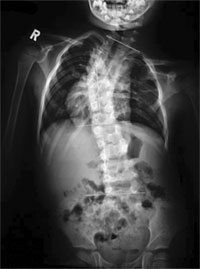Scoliosis

Scoliosis is an abnormal curving of the spine. Normally, the spine is made up of bones that are like blocks placed on top of each other. The spine should be straight when seen from the back and a mirror-image letter 'S' from the side. The spine protects the spinal cord, and nerves coming to and from the spinal cord pass through the spine. The bones in the upper spine are connected to the ribs and help the ribs move when breathing. With scoliosis, the bones are not properly placed on top of the other causing the spine to curve sideways. Scoliosis may worsen slowly, quickly, or not at all. The abnormal curving in the spine may limit chest movement and cause lung or heart problems.
Scoliosis affects two of every 100 children. While many cases do not progress into significant conditions that warrant medical treatment, we have the experience and research background to make that determination early on.
In most cases, the exact cause of scoliosis is not known, especially if the spine was straight before. Idiopathic (unknown cause) scoliosis may affect children during their early, childhood, or late years. Scoliosis that occurs anytime from birth up to three years of age is called infantile scoliosis. If it starts between 3 and 10 years of age, it is called juvenile scoliosis. Scoliosis occurring at more than 10 years of age is called adolescent scoliosis. A birth defect in children's back bones may cause scoliosis. The bones may have formed differently or incompletely, such that only half of the bone is present. Sometimes, the back bones or ribs are abnormally joined together. Instead of dividing into the normal small bones, a large block of bone is formed in the spine.
The treatment of scoilisis depends on the type of curve, age of onset and skeletal maturuity. Generally, the treatment would involve observation, bracing or surgery. The type of brace and surgical methods will be discussed with patient and parents during consultation.




 Adult Orthopaedic
Adult Orthopaedic